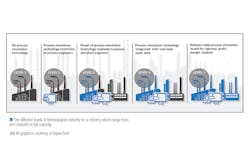The complexity of the refining business grows every day with new markets, new feedstocks and new regulations. Additionally, refineries are facing declining profit margins. To sustain their profitability, refineries must leverage process simulation technology and capabilities to achieve best-in-class operational excellence. Process simulation technologies have advanced substantially to help refineries on a broad range of processes that span operational troubleshooting, crude selection, refinery planning, profit margin analysis and turnaround planning.
While the world of crude oil refining has witnessed significant developments in process simulation, many refiners still leave money on the table by not taking full advantage of the growing range and sophistication of process optimization technology. To understand how a refinery and its process engineers can better use process simulation to improve profit margins, a company’s level of maturity in leveraging process optimization technology should be considered. The maturity levels can range from zero maturity, in which a refinery does not yet have a culture of using process simulation technology to support operations, all the way to full maturity, in which refineries use refinery-wide process simulation models in a single flowsheet. The process engineers in full-maturity refineries offer valuable insights into planning and strategy by bringing a more accurate assessment of profit margins for strategic capital project evaluations and operational improvements, among other benefits.
An inevitable element of a refinery’s journey to higher levels of technological maturity is its partnership with technology providers who can equip it with state-of-the-art technology and industry best practices. The following technological applications are critical for refineries that intend to grow their technological maturity to achieve best-in-class operational efficiency.
Heat exchanger maintenance & monitoring
Since refineries have continuous process operations at low profit margins, any operational inefficiencies or outages have a huge impact on their bottom lines. Heat exchangers are a critical part of the refining process and play a crucial role in determining energy efficiency. Refineries have many different types of heat exchangers in service, and the heat exchanger network layout can impact fuel consumption considerably.
The nature of process streams in a refinery causes frequent fouling of heat exchangers, reducing their effectiveness. This also reduces energy efficiency and increases fuel consumption. To avoid this, heat exchangers must undergo routine cleaning and maintenance. The challenge for refineries is to determine the best time to take each heat exchanger out of service for maintenance so that profits are not affected.
Rigorous simulation of heat exchanger operations within the broader process model allows refineries to estimate the fouling level of each unit and the economic impact each has on the overall process. This helps refineries set up a prioritized maintenance schedule for the heat exchanger network designed to sustain refinery profits.
Disparate tools used for process simulation and heat exchanger design can also lead to challenges for the engineers. The links between these tools may be nonexistent or weak because they are often supplied by different companies, requiring users to manually enter data between them. This process is inefficient and time consuming and, as a result, is often too tedious to pursue.
To overcome these challenges, refiners need a solution with seamless integration between the process simulator and heat exchanger design and rating tools. This enables thorough simulation of heat exchanger operations within the broader process simulation model. The heat exchanger design tool must also simulate all major heat exchanger types used in the refining industry. Furthermore, the solution should allow process engineers to easily develop and integrate their heat exchangers’ simulation as part of the refinery flowsheet without leaving their familiar process simulation environment.
Many companies already use this type of technology. For example, Hindustan Petroleum’s refinery in Mumbai, India, saved more than $250,000 annually. Savings included a great deal of its plant engineer’s time and an improvement in its heat exchanger maintenance schedule. INEOS refinery in Lavera, France, reported a savings of $4 million annually created by using an application to monitor heat exchanger fouling. Refineries that have little to no maturity level stand to gain considerable improvements in their profit margins by integrating solutions that enable simulation tools and plant data to be combined and made available to plant engineers using a familiar interface such as Microsoft Excel. In this way, plant engineers can create well-informed maintenance schedules and establish a more proactive maintenance culture.
Refinery wide process analysis is for every refinery that would like to reach the best practice of technological maturity.
Column operations troubleshooting
When refinery operators observe issues with their column operations, such as column weeping and flooding, they usually resort to past experiences to temporarily relieve the situation. However, these ad-hoc methods only work for operators who have years of experience with the unit. Furthermore, these operational tweaks may only provide temporary relief and could lead to non-optimal functioning of the broader process unit. Another issue is that this lack of insight into the internal operations of the column forces refineries to operate them conservatively to meet product specifications. This causes additional energy to be consumed in reboilers and reflux condensers, increasing costs.
The ideal solution sheds light on the root cause of operational issues without requiring a unit shutdown or expensive physical inspections. Some advanced process simulation solutions offer visualization into the operating point of the unit, the ability to predict the impact of alternative courses of action and the ability to select the most optimal action.
An effective solution must also include an integrated process simulator that accurately simulates the thermal and hydraulic behavior of the column unit to provide enough information to support column operations. This precision and depth of option are needed to give the process engineers the confidence to recommend effective operating decisions. Without this, engineers conduct their analysis through the tedious workflow of switching back and forth between separate software tools for process simulation and column analysis.
With the correct process simulation software, users can accurately simulate thermo-hydraulic functioning of columns based on their construction and operating conditions. As a result, they can better understand the columns’ behavior and avoid operational mishaps. Simulating the operation of the column in the broader setting of the overall process enables users to identify root causes of the problems and determine the optimal point of operation for the overall process unit. Moreover, visualization tools can provide insight into the operating point of the column and impending breach of operational limits that cause issues such as jet flooding, weeping and down-comer backup. With these capabilities, refineries can build a work culture of continual process optimization and preventive maintenance by taking advantage of advanced process simulation technology.
Integrated refining & gas plant analysis
Petroleum refineries use many integrated complex processes that can make maximizing margins while meeting production targets, product specifications and regulatory requirements difficult. In recent years, refinery crude slates have diversified significantly, as refiners try to increase margins by lowering feed costs. As crude oils and unconventional feedstocks continue to get heavier and more sour, increasing demand is placed on processes in the downstream gas plant such as acid gas treating and sulfur recovery. Refiners must continue to meet the same emissions standards with these challenging feeds. One way to do this is with the aid of advanced process simulation technology.
Refineries need a solution that meticulously simulates the entire gas plant including acid gas treatment units, sulfur recovery, tail gas units and flare systems together with the mainstream refining process units, such as distillation units and reactor units. This advanced technology would provide the refiners enough confidence to push the levels of sour crudes closer to the limit the refinery can process while meeting regulations.
With the integrated solutions available today, engineers have the tools to create an accurate simulation of refining and gas plant operations in one simulation environment. This allows refinery operators to assess whether they can accommodate increased levels of sour crudes in their refinery and preemptively adjust plant operations accordingly. Feed flexibility, capacity creep and operating expenditure optimization, enabled using integrated refining and gas plant process simulation, can save refiners millions each year in operating margins while ensuring maximum reliability and plant uptime. In addition, the rigorous simulation of the gas plant operation offers refineries visibility and the ability to better document their emission levels. This capability is valuable for boosting their profit margins.
Planning model update for refineries
Refineries use planning tools to make decisions on how to manage and control their operations. Decisions on what crude oil to process, what product slate to produce and how to operate the refinery to maximize profits are made by considering the continually fluctuating global market and the capacity constraints of the refinery. Traditionally linear programming (LP) models are employed by these planning tools to analyze hundreds of alternative options to find the most optimal plan. These LP models are relatively fast at analyzing the numerous scenarios that the planners are required to process daily.
However, one limitation of the LP models used by these planning tools is that they are accurate only within a specific operating range of the refinery. As time passes, refineries often move away from that operating range, for example, because of catalyst deactivation or other operational changes. As a result, LP models become outdated and reduce the effectiveness of the planning tools’ ability to help with the most optimal operational decisions, which could potentially cost millions in lost profits. While many refineries depend on expensive external consultants and experts to update their planning models, they can cost more time and money. Additionally, any delay in updating the planning model can mean lost profit.
The ideal option is to give refinery process engineers the ability to maintain the planning models with the help of advanced process simulation software that offers a streamlined workflow to update the planning models, enabling frequent updates when the models become out of sync with the operating range of the refinery. The process simulation software has the predictive capability that comes with rigorous process analysis based on reaction kinetics and heat and mass balance. With these advanced tools, refiners can follow the workflow themselves, rather than remaining dependent on expensive outside consultants. Leading solution providers who offer both process simulation and a refinery planning solution have built-in integration between these solutions that makes the workflow of updating planning models more streamlined.
Taiyo Oil in Japan reported a 12.7 percent increase in its refinery’s profit from maintaining the refinery planning and scheduling tools using advanced process simulation solutions. This application can help all refineries build a culture of true partnership between planners and process engineers to maintain planning and scheduling tools for maximized and sustained refinery profits.
Refinery-wide process analysis
The scale and complexity of refining processes pose a big challenge for refineries in their effort to conduct a holistic analysis of their operation. They need a solution that will provide the precision of a process simulator without the complexity and expense that an in-depth, refinery-wide process simulation model entails. The solution should also be one that can be maintained in-house without having to remain dependent on expensive consultants.
Luckily, current solutions are available that offer a unique way of developing a refinery-wide process simulation model that is both manageable and accurate. With an advanced integrated solution for process simulation and refinery planning, refineries can develop a refinery-wide process model out of their refinery-wide planning model in a relatively short period of time. The accuracy of the simulation model can be enhanced by selectively incorporating rigorous models of reactor units to the refinery-wide flowsheet. In this methodology users have full control over the level of rigor and flexibility of the model, and it can be used for rigorous profit-margin analysis, when evaluating strategic reconfiguration options or operational improvements to the refinery. This is also an effective tool in evaluating responses to unexpected operational events and in determining turnaround and start-up plans.
Overall, refinery-wide process analysis is for every refinery interested in reaching the best practice of technological maturity. With this solution, refineries can use the model to accurately assess the economic impact of possible strategic reconfiguration projects and support planners for special cases when they need a more accurate information than that projected by their LP tools. Additionally, refineries require employees who are skilled in the latest technology and industry best practices. By working with a technological partner who can present them with a comprehensive, end-to-end solution platform they can use to improve their technological maturity, refineries can achieve world-class operational efficiency without depending on expensive consultants. With these tools, refinery process engineers can continually develop their skill sets and process knowledge to become world-class engineers.
Sandeep Ram Mohan is a product expert with a focus on engineering solutions for the refining industry. Prior to joining AspenTech, Mohan worked as a thermal/process engineer in the engineering, procurement and construction industry. He holds a master’s degree from Rensselaer Polytechnic Institute in New York.
AspenTech
www.aspentech.com




